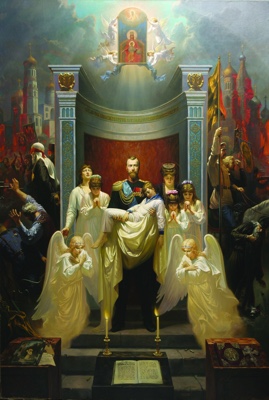Jews Watch Out: Russian Officials Have Revived the Ancient Blood Libel Against Jews

On November 27, 2017, the Federal Investigative Committee – Russia’s equivalent of the FBI – announced that it would look into the claim that the execution of Tsar Nicholas II and his family in the basement of a merchant’s mansion in Ekaterinburg in July 1918 was a “ritual killing.” A special commission of the Russian Orthodox Church had worked on the case since September 2015, when a Russian court reopened an investigation into the murder of the Romanov family. As part of the probe, investigators exhumed the remains of the tsar and tsarina from their tomb in Peter and Paul Fortress in St. Petersburg.
 The Federal
Investigative Committee’s stunning announcement followed the
gathering of a commission at Moscow’s Sretensky Monastery to
discuss the ritual nature of Nicholas’s murder. Bishop Tikhon
Shevkhunov, an influential figure with close ties to Vladimir Putin,
told the TASS news agency, “We strongly favor the view that it was
a ritual murder. What’s more, for a significant part of the church
commission, there is no doubt that is what happened.”
The Federal
Investigative Committee’s stunning announcement followed the
gathering of a commission at Moscow’s Sretensky Monastery to
discuss the ritual nature of Nicholas’s murder. Bishop Tikhon
Shevkhunov, an influential figure with close ties to Vladimir Putin,
told the TASS news agency, “We strongly favor the view that it was
a ritual murder. What’s more, for a significant part of the church
commission, there is no doubt that is what happened.”
The renewed claim drew a fierce outcry. Liudmila Narusova, a lawmaker in the Federation Council, told Interfax that the allegations mark a “return to some kind of obscurantism.” Russia’s Jewish organizations protested the claim, as well. Boruch Gorin, a spokesperson for the Federation of Jewish Communities of Russia, was also shocked at the absurdity of the allegations. “We all think of this as absolutely unacceptable,” Gorin told Interfax.
Originating in England with the 1144 case of William Norwich, the accusation – that Jews allegedly murder Christian children for ritual purposes – enjoyed popular appeal for hundreds of years. The most publicized case was that of Mendel Beilis, who was accused of ritually murdering the thirteen-year-old boy Andrei Iuschchinskii on March 20, 1911. The Beilis trial was widely reported in newspapers worldwide and became an international cause célèbre.
Russia has had a long history of promoting ritual murder accusations. The blood libel survived on Russian soil since the end of the eighteenth century, when the Russian government acquired the largest Jewish population in the world as a consequence of the partitions of the Polish-Lithuanian Commonwealth. In the first half of the nineteenth century, almost all of the documented cases occurred in present-day Lithuania and Belarus. Here, an unusually high proportion of the inhabitants – from the common folk to the well-educated members – believed that Jews were capable of committing the crime.
In 1816, several Jews in Grodno were blamed for the death of a peasant girl whose arm had been cut off at the shoulder blade and whose body had several puncture wounds. Similar accusations surfaced from time to time. In 1821, rumors circulated that Jews were responsible for another grisly death after the body of a young woman was found in the Western Dvina.
The most sensational case took place in Velizh, a small town located on the northeastern edge of the Pale of Settlement. Now erased from historical memory, the Velizh affair was the longest ritual murder case in the modern world, and most likely in world history. The case lasted approximately twelve years, from 1823 to 1835, and resulted in charges of ritual murder against forty-three Jews. Unlike the Beilis trial, the Velizh case was conducted in strict secrecy, according to the guidelines established by the inquisitorial procedure code. Imprisonment took a physical and an emotional toll on the prisoners. Standing in front of the commission, many Jews found it difficult to cope with the trauma of the oral interrogations. Some individuals had a hard time getting their point across in a language only a handful of people knew reasonably well. Others succumbed to depression from which they never fully recovered.
By the fall of 1828, the Velizh inquisitorial commission amassed an impressive dossier: a forensic report, an assortment of confessions, one blood-stained cloth, two knives, a piece of foreskin, and reference works that clearly established the theological origins and historicity of ritual murder.
The Velizh case reached the Senate and the State Council, the highest judicial bodies in the Russian Empire. Eventually, the charges against the Jews were dropped. Convicting Jews of blood sacrifice required empirical evidence of the highest order. Yet however powerful the evidence may have been in the Jews’ favor, Tsar Nicholas I was wary of dismissing the ritual murder charge outright. “I do not have and indeed cannot have the inner conviction,” he stated, “that the murder has not been committed by Jews.” Numerous examples from different times and places around the world, he believed, revealed that “among Jews there probably exist fanatics or sectarians who consider Christian blood necessary for their rites.”
Leaving open the possibility of ritual intent, Nicholas I’s opinion in 1835 cast a lingering shadow over all future blood accusations. As the recent events suggest surrounding the Russian Orthodox Church’s probe into the 1918 execution of the Romanovs, for many Russians, it’s entirely within the realm of perceived wisdom that Jews could commit the crime at any time and place.
